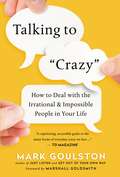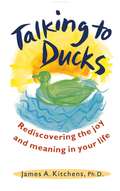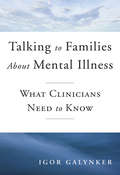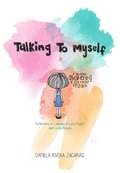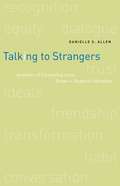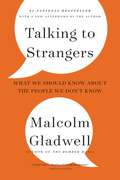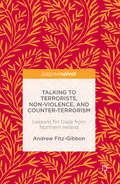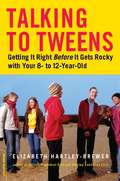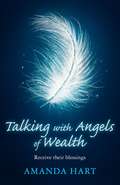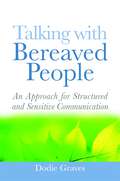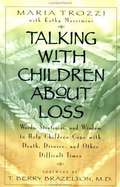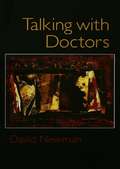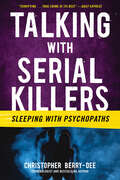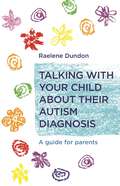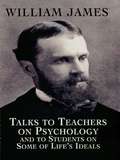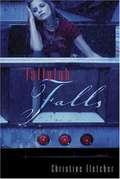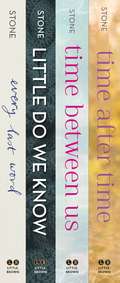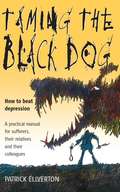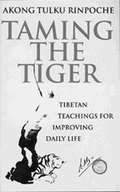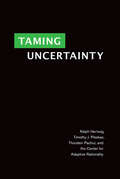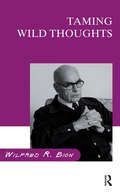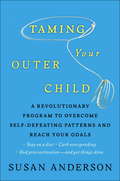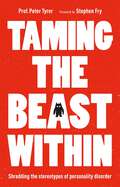- Table View
- List View
Talking to Crazy: How to Deal with the Irrational and Impossible People in Your Life
by Mark GoulstonLet's face it, we all know people who are irrational. No matter how hard you try to reason with them, it never works. So what's the solution? How do you talk to someone who's out of control? What can you do with a boss who bullies, a spouse who yells, or a friend who frequently bursts into tears?In his book, Just Listen, Mark Goulston shared his bestselling formula for getting through to the resistant people in your life. Now, in his breakthrough new book Talking to Crazy, he brings his communication magic to the most difficult group of all--the downright irrational.As a psychiatrist, Goulston has seen his share of crazy and he knows from experience that you can't simply argue it away. The key to handling irrational people is to learn to lean into the crazy--to empathize with it. That radically changes the dynamic and transforms you from a threat into an ally. Talking to Crazy explains this counterintuitive Sanity Cycle and reveals:Why people act the way they doHow instinctive responses can exacerbate the situation--and what to do insteadWhen to confront a problem and when to walk awayHow to use a range of proven techniques including Time Travel, the Fish-bowl, and the Belly RollAnd much moreYou can't reason with unreasonable people--but you can reach them. This powerful and practical book shows you how.
Talking to Ducks: Rediscovering The Joy and Meaning In Your Life
by James KitchensThe purpose of life is joy. James A. Kitchens, in this wonderfully engaging book, helps us to remember our life's purpose and to realize that the key to our own happiness lies within us-- in our souls. He invites us to experience the happiness, love, and satisfaction that are ours if we are only willing to look for them-- even if it is by talking to a duck. Through examples from the author's own life and his patients' lives, as well as from literature, "Talking to Ducks" guides us to discover the beauty of our internal and external worlds.
Talking to Families about Mental Illness: What Clinicians Need to Know
by Michelle Foster Janine Samuel Igor Galynker Annie SteeleA clinician's guide to understanding and responding to the concerns of family members whose loved one suffers from mental illness. Will he always need medication? How should I explain his illness to the children? What should I say to him to be supportive? How should I behave? A diagnosis of a mental illness can change a person forever--indeed, in some cases it can affect the rest of the life course. It can also have a deep and lasting impact on those close to them. Loving and caring, but often frustrated and at times depressed themselves, family members and caregivers have plenty of questions for the psychiatrists, primary care physicians, and other counselors or therapists who are caring for their mentally ill loved one. Here, veteran clinician Igor Galynker equips mental health professionals with everything they need to know to speak with family members compassionately and effectively, conveying treatment information and answering their questions, while also relieving their anxieties. Drawing from years of his own clinical experience, he offers tools for communicating with families about psychiatric symptoms, medications, and alternative treatment options--along with the difficult topics of stigma, denial, and suicide. He covers the ins and outs of schizophrenia, bipolar mood disorder, major depressive disorder, generalized anxiety disorder, panic disorder, obsessive-compulsive disorder, and personality disorders, and outlines the course of each illness, symptoms, and implications for the client's future and relationships. Finally, he offers advice for managing stress, succeeding at school and work, building strong romantic relationships, and planning families. Clinical case examples throughout showcase Galynker's narratives in practice, and prepare clinicians for families' reactions, both good and bad. Whether you are a general practitioner or psychiatric specialist, or concerned loved one, Talking to Families About Mental Illness will enhance your ability to manage a family's difficult questions and concerns, which can ultimately transform the way they handle the patient's diagnosis. This book provides all the tools necessary to communicate clearly and effectively, and guide patients and their families on the path to healing.
Talking to Myself: Reflections on Learning to Love Myself and Living Bravely
by Daníela Rivera ZacaríasDaníela Rivera Zacarías believes everything happens for a reason, even if we cannot see it at the moment. This book began as her personal journal, her own attempt to discover her place in the world through analyzing experiences, relationships, and spiritual encounters. It evolved into a book—and then the beloved Hablando Sola brand with more than 2,100,000 Facebook likes—full of thoughtful questions and meaningful reflections that has inspired and uplifted hundreds of thousands of young people in Latin America. Now the book that has sold more than 200,000 copies in Latin America is available in English, coinciding with the brand’s expansion into the United States as Talking to Myself.Zacarías guides readers on their own self-discovery journeys through simple, accessible musings and anecdotes. "How do you learn to love yourself?” she asks and then continues, "I think it’s impossible if you don’t know who you are.” The ensuing chapters include Love, Fear, God, Art, Beauty, Depression, Happiness, and more, tackling a wide range of subjects with one goal in mind: helping readers to better know themselves, that they might better love themselves.This book comes alongside you like a big sister who’s been there and done that and can impart her wisdom between warm hugs and a few laughs. It will be of special interest to the 54 million Hispanic Americans in the United States because of Zacarías’s following in Latin America, but its honesty, warmth, and wisdom will give it broad appeal, particularly to young women.
Talking to Strangers: Anxieties of Citizenship since Brown v. Board of Education
by Danielle S. Allen"Don't talk to strangers" is the advice long given to children by parents of all classes and races. Today it has blossomed into a fundamental precept of civic education, reflecting interracial distrust, personal and political alienation, and a profound suspicion of others. In this powerful and eloquent essay, Danielle Allen, a 2002 MacArthur Fellow, takes this maxim back to Little Rock, rooting out the seeds of distrust to replace them with "a citizenship of political friendship. "Returning to the landmark Brown v. Board of Education decision of 1954 and to the famous photograph of Elizabeth Eckford, one of the Little Rock Nine, being cursed by fellow "citizen" Hazel Bryan, Allen argues that we have yet to complete the transition to political friendship that this moment offered. By combining brief readings of philosophers and political theorists with personal reflections on race politics in Chicago, Allen proposes strikingly practical techniques of citizenship. These tools of political friendship, Allen contends, can help us become more trustworthy to others and overcome the fossilized distrust among us. Sacrifice is the key concept that bridges citizenship and trust, according to Allen. She uncovers the ordinary, daily sacrifices citizens make to keep democracy working and offers methods for recognizing and reciprocating those sacrifices. Trenchant, incisive, and ultimately hopeful, Talking to Strangers is nothing less than a manifesto for a revitalized democratic citizenry.
Talking to Strangers: What We Should Know about the People We Don't Know
by Malcolm GladwellMalcolm Gladwell, host of the podcast Revisionist History and author of the #1 New York Times bestseller Outliers, offers a powerful examination of our interactions with strangers--and why they often go wrong. <P><P>How did Fidel Castro fool the CIA for a generation? Why did Neville Chamberlain think he could trust Adolf Hitler? Why are campus sexual assaults on the rise? Do television sitcoms teach us something about the way we relate to each other that isn't true? <P><P>Talking to Strangers is a classically Gladwellian intellectual adventure, a challenging and controversial excursion through history, psychology, and scandals taken straight from the news. He revisits the deceptions of Bernie Madoff, the trial of Amanda Knox, the suicide of Sylvia Plath, the Jerry Sandusky pedophilia scandal at Penn State University, and the death of Sandra Bland---throwing our understanding of these and other stories into doubt. <P><P>Something is very wrong, Gladwell argues, with the tools and strategies we use to make sense of people we don't know. And because we don't know how to talk to strangers, we are inviting conflict and misunderstanding in ways that have a profound effect on our lives and our world. In his first book since his #1 bestseller, David and Goliath, Malcolm Gladwell has written a gripping guidebook for troubled times. <P><P><b>A New York Times Bestseller</b>
Talking to Terrorists, Non-Violence, and Counter-Terrorism
by Andrew Fitz-GibbonThis book examines the history of "the Troubles" in Northern Ireland in the 1970s-1990s and compares it with the situation in the Gaza Strip. The book takes as its cue the tragic events in Gaza in July 2014, when Israel launched Operation Protective Edge which began seven weeks of bombardment of Gaza and which led to rocket attacks by the Palestinians on Israel. In all over 2,200 people were killed. The book provides a brief history of the violence in both countries. It then analyzes the Northern Ireland Peace Process that resulted in the Good Friday Agreement in 1998, which ended decades of violence and led to relative peace in Northern Ireland through the process of "talking to terrorists. " The book suggests seven creative lessons for a peaceful way forward between the Israelis and the Palestinians.
Talking to Tweens: Getting It Right Before It Gets Rocky with Your 8- to 12-Year-Old
by Elizabeth Hartley-BrewerThey may look sweet and compliant, but these days children aged between 8 and 12-"tweens” -are fast emerging as a force to be reckoned with. Gaining in confidence, expecting more freedom, and increasingly targeted commercially, they present many new and challenging issues for parents. But getting the relationship right during these important years can build a rewarding trust and openness that will see parents through the rocky teenage years ahead. Giving sound advice that is firmly rooted in the real world and based on a clear understanding of tweens’ needs, parenting expert Elizabeth Hartley-Brewer explains how staying close to our children while beginning to let go helps us achieve the balance that is so important for the parent-child relationship. Tackling everyday issues of real concern,Talking to Tweensoffers practical, down-to-earth, and reassuring guidance on: Self-discipline, consideration, and kindnessPeer pressure and bullyingAllowances and spending moneyBody image and healthy eatingSex and pubertyFamily disruptionsRisk, danger, and responsibilitySchool problems and work pressureNurturing self-esteem and identity
Talking with Angels of Wealth: Receive Their Blessings
by Amanda HartAmanda Hart was rescued by guardian angels as a child and from thence on they became a beacon of hope throughout her turbulent journey into womanhood. The illuminating conversations she has with her angels remain an important aspect of her everyday life, bringing her continual support and spiritual fulfillment. She now dedicates her life to helping others connect with their own angels, helping them to find deeper meaning and happiness in their lives.
Talking with Bereaved People
by Dodie GravesIt can be hard to know what to talk about with a bereaved person over a period of time once you have offered your condolences. This book shows how, by using good active listening skills, empathic exploration and a willingness to talk about the hard issues, you can embark on a process of sensitive conversation that helps the bereaved person to come to terms with their grief. Dodie Graves outlines a practical framework of six elements for conversing with bereaved people in a structured but flexible way that avoids prescriptive instructions. The elements include talking about the story of the deceased, their relationship with the person, celebrating their life, discussing their legacy, strategies for coping and thinking about the journey undertaken. She shows how to use the elements in conversations with individuals and groups, and for each element suggests creative activities and open questions that can be used, provides anecdotes and case vignettes, and gives a brief summary of the theory pertinent to each stage of the conversation. Talking with Bereaved People is an approachable tool for anyone working with bereaved people, including counsellors, voluntary bereavement agencies, church pastoral teams, hospice and hospital staff, trainers and social workers.
Talking with Children About Loss: Words, Strategies, and Wisdom to Help Children Cope with Death, Divorce, and Other Difficult Times
by Maria TrozziThrough captivating stories and thoughtful analysis, Maria Trozzi explains how to handle the difficult job of talking with children and adolescents about loss, with discussions about: * How children perceive and interpret events such as death, disability, and divorce * Guiding children through the four tasks of mourning * Helping children face funerals, wakes, and memorial services * Children's fears and fantasies: how they express them, and how to address them * Age-appropriate responses to children's questions and concerns * Talking to children about long-term illness, suicide, family or community tragedy, and other special situations * What to do when children won't talk about loss, and when to seek professional help
Talking with Doctors
by David NewmanWithout any warning, in September 1999, David Newman was told he had a rare and life-threatening tumor in the base of his skull. In the compressed space of five weeks, he consulted with leading physicians and surgeons at four major medical centers. The doctors offered drastically differing opinions; several pronounced the tumor inoperable and voiced skepticism about the effectiveness of any nonsurgical treatment. Talking with Doctors is the story of Newman's efforts, at a time of great stress and even impending death, to wend his way through the dense thicket of medical consultations in search of a physician and a treatment that offered the possibility of survival. It is the story, especially, of the harrowing process of assessing conflicting "expert" opinions and, in so doing, of making sense of the priorities, personalities, and vulnerabilities of different doctors. All too often, he found, the leading specialists to whom he was sent were strangers in the consulting room-and strangers who became stranger still, both cognitively and emotionally, when ambiguous findings pushed them to the outer limits of their training and experience. Newman writes poignantly of his sense of powerlessness and desperation, of the painstaking means by which he ascertained what could be known about his tumor, and of the fortuitous events that finally led him to life-saving help. Talking with Doctors is a compelling, absorbing, unsettling story that touches a collective raw nerve about the experience of doctors and medical care when life-threatening illness leads us to subspecialists at major medical centers. Probing the nature of medical authority and the grounds of a trusting doctor-patient relationship, Newman illuminates with grace and power what it now means for a patient to participate in life-and-death medical decisions.
Talking with Serial Killers: Sleeping with Psychopaths (Talking with Serial Killers)
by Christopher Berry-DeeExclusive, first-hand accounts of the men and women who have slept with infamous killers in a book praised as “terrifying . . . true crime at its best” (Daily Express).Bestselling true crime writer and criminologist Christopher Berry-Dee turns his attention to a new kind of victim: the wives and partners of serial murderers who remained unaware of exactly who they had fallen for until after their other half’s arrest or, in some cases, conviction. Only upon Peter’s arrest did Sonia Sutcliffe first discover that her husband was leading a secret existence as the Yorkshire Ripper. The wife of the Hillside Strangler only learned of her husband’s crimes when state police smashed down her door in search of him. When finding out the truth, these innocents have to face the grim reality of betrayal and deceit and often experience guilt for not having recognized the killer in their home. Christopher Berry-Dee speaks directly with killers and their oblivious loved ones to get inside the minds of the men and women who fall for murderers.
Talking with Your Child about Their Autism Diagnosis: A Guide for Parents
by Raelene DundonTelling your child about their autism diagnosis can be daunting. Will they be better off for knowing? What's the right way to tell them? Should you inform anyone else too? As a mother of two children on the spectrum, with over ten years' experience as a psychologist specialising in childhood autism, Raelene Dundon has all the tips you'll need. In this concise book, she sets out case studies, examples and resources that will equip you to make your own informed choices and help your whole family to live well with autism. Part One provides ways to tell children of different ages and development levels about their diagnosis, including photocopiable and downloadable worksheets designed to help diagnosed children understand autism, and gives advice on what to do if they react in a negative or unexpected way to the news. Part Two explores the pros and cons of sharing the diagnosis with others, including family, friends, school staff and your child's classmates, and guides you through what to do if others don't understand or accept the diagnosis.
Talks to Teachers on Psychology: and to Students on Some of Life's Ideals
by William JamesStill-vital lectures on teaching deal with psychology and the teaching art, the stream of consciousness, the child as a behaving organism, education and behavior, and more. The three addresses to students are "The Gospel of Relaxation," "On a Certain Blindness in Human Beings," and "What Makes a Life Significant?" Preface. 2 black-and-white illustrations.
Tallulah Falls
by Christine FletcherWhen Tallulah Addy sets out on an impulsive cross-country trip to rescue her best friend, she doesn't anticipate getting stranded in rural Tennessee without a dime. Nor does she guess that rescuing a dog will land her a job in the local veterinarian's office. But there, under the wary eye of ornery Dr. Poteet, Tallulah works harder than ever before, tending to animals of all shapes and sizes--and unexpectedly, to wounds long-buried in herself. Tallulah swears she'll leave the first chance she gets, yet when given the choice, it may prove harder to keep the promise to her friend than to say good-bye to the strangers who have become her new family.
Tamara Ireland Stone Collection
by Tamara Ireland StoneDiscover four critically-acclaimed novels from award-winning author Tamara Ireland Stone, including the New York Times bestseller Every Last Word.In the New York Times bestselling Every Last Word, Samantha McAllister looks just like the rest of the popular girls in her junior class. But she&’s hiding a secret that her friends would never understand: Sam has Purely-Obsessional OCD and is consumed by a stream of dark thoughts and worries that she can't turn off. It doesn't help that her lifelong friends will turn toxic at the first sign of a wrong outfit, wrong lunch, or wrong crush. So when Sam meets Caroline, she has to keep her new friend a secret, right up there with Sam's weekly visits to her psychiatrist. But then Caroline introduces Sam to Poet's Corner, a tight-knit group of misfits who have been ignored by the school at large. Sam is drawn to them immediately, especially a guitar-playing guy with a talent for verse. Slowly, she begins to feel more "normal" than she ever has as part of the popular crowd . . . until she finds a new reason to question her sanity and all she holds dear.In Little Do We Know, lifelong best friends and next-door neighbors Hannah and Emory have never gone a single day without talking. But now it&’s senior year and they haven't spoken in three months. Not since the fight, where they each said things they couldn't take back. Then one fateful night, Emory's boyfriend, Luke, almost dies, and Hannah is the one who finds him and saves his life. As Luke tries to make sense of his experience, he secretly turns to Hannah, who becomes his biggest confidante. And in Luke, Hannah finds someone she can finally talk to. But Emory just wants everything to go back to normal—the way it was before the accident. But when the horrifying reason behind Hannah and Emory's argument ultimately comes to light, all three of them will be forced work together to protect the one with the biggest secret of all in this deeply moving, unforgettable story about love, betrayal, and the power of friendship.In Time Between Us, Anna and Bennett were never supposed to meet. She lives in 1995 Chicago and he lives in 2012 San Francisco. But Bennett's unique ability to travel through time and space brings him into Anna's life, and with him, a new world of adventure and possibility. As their relationship deepens, they face the reality that time might knock Bennett back where he belongs, even as a devastating crisis throws everything they believe into question. Against a ticking clock, Anna and Bennett are forced to ask themselves how far they can push the bounds of fate—and what consequences they can bear in order to stay together.In the sequel to Time Between Us, Time After Time, Anna and Bennett have found a way to stay together against all odds. It&’s not a perfect arrangement, though, with Bennett unable to stay in the past for more than brief visits, skipping out on big chunks of his present in order to be with Anna. They each are confident that they&’ll find a way to make things work…until Bennett witnesses a single event he never should have seen. Will the decisions he makes from that point on cement a future he doesn&’t want?
Taming Tension
by W. Phillip KellerWith his usual compassionate and conversational style, Keller talks about tension: its causes, its affects, and what we can do about it. His advice is practical, well-researched, and always based on Biblical principles. An excellent book for anyone who is (or expects to be) feeling stress-out.
Taming The Black Dog: How To Beat Depression. A Practical Manual For Sufferers, Their Relatives And Their Colleagues
by Patrick EllvertonThis self help manual is for those for whom depression arises from the impact of exceptional circumstances such as childbirth and menopause, commercial and professional failure, accident, grief, divorce or debt as well as for those more permanent owners of the Black Dog.Contents: 1. Preface; 2. Your first step; 3. Medication; 4. Causes; 5. Manage your life; 6. Repulsing attacks; 7. Habits for repairing damage; 8. Utilising your subconscious computer; 9. Praying; 10. Vitality; 11. Sleeping; 12. Healthy eating; 13. Alcohol; 14. Fitness
Taming The Black Dog: How to Beat Depression - A Practical Manual for Sufferers, Their Relatives and Colleagues
by Patrick EllvertonThis self help manual is for those for whom depression arises from the impact of exceptional circumstances such as childbirth and menopause, commercial and professional failure, accident, grief, divorce or debt as well as for those more permanent owners of the Black Dog.Contents: 1. Preface; 2. Your first step; 3. Medication; 4. Causes; 5. Manage your life; 6. Repulsing attacks; 7. Habits for repairing damage; 8. Utilising your subconscious computer; 9. Praying; 10. Vitality; 11. Sleeping; 12. Healthy eating; 13. Alcohol; 14. Fitness
Taming The Tiger: Tibetan Teachings For Improving Daily Life
by Akong Tulku RinpocheTAMING THE TIGER offers a simple approach to finding happiness for oneself that also brings happiness to others. Based on twenty years of Buddhist teaching in the West, Taming the Tiger aims to help anyone seeking the truth about suffering and happiness. The first part of the book deals with topics such as Impermanence, The Right Motivation, Facing the Situation, Body, Speech and Mind, Compassion, and Mindfulness. The second part is devoted to exercises, meditations and relaxation techniques for body and mind, including Feeling, Openness, Taking Suffering, Bringing the Buddha to Life and Universal Compassion. The exercises, designed to provide a base of self-knowledge, mind-therapy and self-healing have also been found beneficial in therapy workshops and in the treatment of psychological problems.This practical programme has been tested and refined first at therapy workshops of Samye Ling in Scotland - the oldest Tibetan Buddhist centre in the West - and has since confirmed its success in cities throughout Europe, North America and Africa, bringing definitive solutions to long-term problems weighing heavily on the mind.
Taming Uncertainty
by Ralph Hertwig Timothy J. Pleskac Thorsten PachurAn examination of the cognitive tools that the mind uses to grapple with uncertainty in the real world. How do humans navigate uncertainty, continuously making near-effortless decisions and predictions even under conditions of imperfect knowledge, high complexity, and extreme time pressure? Taming Uncertainty argues that the human mind has developed tools to grapple with uncertainty. Unlike much previous scholarship in psychology and economics, this approach is rooted in what is known about what real minds can do. Rather than reducing the human response to uncertainty to an act of juggling probabilities, the authors propose that the human cognitive system has specific tools for dealing with different forms of uncertainty. They identify three types of tools: simple heuristics, tools for information search, and tools for harnessing the wisdom of others. This set of strategies for making predictions, inferences, and decisions constitute the mind's adaptive toolbox. The authors show how these three dimensions of human decision making are integrated and they argue that the toolbox, its cognitive foundation, and the environment are in constant flux and subject to developmental change. They demonstrate that each cognitive tool can be analyzed through the concept of ecological rationality—that is, the fit between specific tools and specific environments. Chapters deal with such specific instances of decision making as food choice architecture, intertemporal choice, financial uncertainty, pedestrian navigation, and adolescent behavior.
Taming Wild Thoughts
by Wilfred R. BionTaming Wild Thoughts brings together previously unpublished works from two different periods of the author's life which are linked, as the author says in her introduction, by the concept of classifying and conceptualizing thought. The first paper, "The Grid", dates from 1963 and is a discussion of great clarity about one of the author's most widely-used conceptual tools; it predates his more discursive paper of the same title (published in Two Papers) by several years. As a teaching paper on this topic, this version of "The Grid" is without parallel, and will doubtless be of great value to all students of his work. The second part of the book consists of transcripts of two tape-recordings made by Bion in 1977. They underline his interest in "wild" or "stray" thoughts; and they provide an insight into his extraordinary sensibility at the time of A Memoir of the Future.
Taming Your Outer Child
by Susan AndersonFINALLY, THE BREAKTHROUGH BOOK THAT PUTS YOU BACK IN CONTROL OF YOUR LIFE Most of us have met our Outer Child once too often. The self-sabotaging, bungling, and impulsive part of the personality. This misguided, hidden nemesis--the devil on your shoulder--blows your diet, overspends, and ruins your love life. A menacing older sibling to your emotionally needy Inner Child, your Outer Child acts out and fulfills your legitimate childlike needs and wants in the wrong place, at the wrong time, and in counterproductive ways: It goes for immediate gratification and the quick fix in spite of your best-laid plans. Food, attention, emotional release--your Outer Child usually gets what it wants, and your Adult self can feel powerless to stop it. Now, in a revolutionary rethinking of the link between emotion and behavior, veteran psychotherapist and theoretician Susan Anderson offers a three-step, paradigm-shifting program to tame your Outer Child's destructive behavior. This dynamic, transformational set of strategies--action steps that act like physical therapy for the brain--calms your Inner Child, strengthens your Adult Self and releases you from the self-blame and shame that are the root of Outer Child issues, and paves new neural pathways that can lead to more productive behavior. Discover* the common Outer Child personality types, including the Drama Queen; the Master of Disguise; My Way or No Way; and Love the Getting, not the Having * proven techniques to resolve underlying sources of self-sabotage * insights that will allow you to stop blaming your supposed "lack of willpower" for your problems * key strategies for healing the painful issues of your past * mental exercises that effectively deal with Outer Child challenges around food, procrastination, love, debt, depression, and more As your head, heart, and behavior come together and learn to help, not hurt, one another, your strong Adult Self, contented Inner child, and tamed Outer child will become a reality. The result is happiness and fulfillment, self-mastery, and self-love.From the Hardcover edition.
Taming the Beast Within: Shredding the Stereotypes of Personality Disorder
by Peter TyrerForeword by Stephen FryControversy and confusion surround personality disorder (PD). Long dismissed as impossible to treat, PD has become a catch-all for various conditions, abounding with negative stereotypes and incorrect information. Now, revised and simpler classifications devised for the World Health Organization (WHO) should make diagnosis and treatment more straightforward. This book, by Professor Peter Tyrer, chair of the advisory body for the WHO, presents new ways of looking at personality. Taming the Beast Within explores the strengths as well as the difficulties of personality, so that all can come to an informed and tolerant understanding of PD. Topics include:what personality is`normal? and `abnormal? personalitieshow mental illness differs from personality disorderpolitics and personalitythe roots of disturbancetypes of disorder, including borderline personality disorderhelping yourself and othersnidotherapy and other approaches drug treatmentsProfessor Peter Tyrer says, `I hope this book will help people with PD, their families and friends, and everyone involved in managing this very common condition. Using our personality strengths, and accepting that some difficulties with others may be self-generated, are the key to understanding. The title of this book can then be changed ? no longer a beast within, just a pussy cat!?
